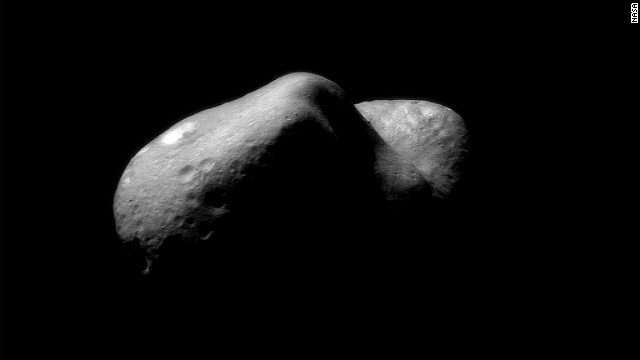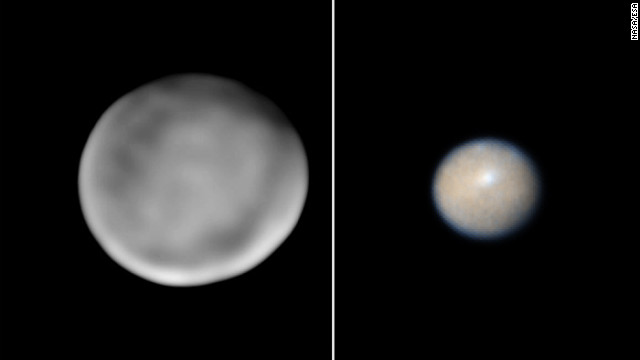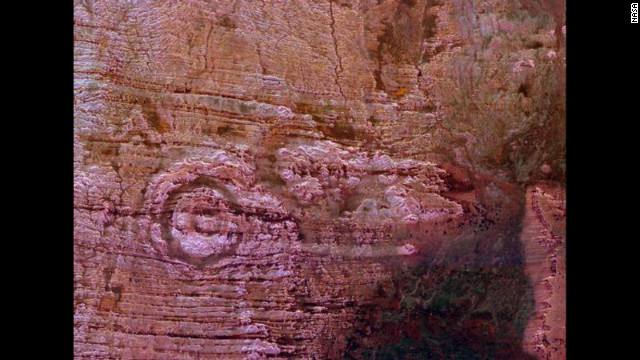- Meteorite crashed in woods in Nicaraguan capital on Sunday, government says
- Crater is 39 feet across
- Hunt is on for remains of meteorite
(CNN) -- A meteorite crashed down in Managua, Nicaragua, late Saturday night, causing a loud explosion and leaving a crater 39 feet (12 meters) across, government officials said, according to The Associated Press. No damage or injuries were reported.
AP quoted government spokeswoman Rosario Murillo as saying they've determined it was a "relatively small" meteorite that "appears to have come off an asteroid that was passing close to Earth."
NASA hasn't confirmed a link between the meteorite and the asteroid. The newly discovered asteroid, called 2014 RC, was expected to pass safely above the Earth on Sunday, NASA said, at a distance of about 25,000 miles (40,000 kilometers) -- just one-tenth the distance from the center of Earth to the moon. It was estimated to be 60 feet (18 meters) long.
 This graphic shows the path Asteroid 2014 RC will take as it passes Earth on Sunday, September 7. The space rock will come within one-tenth the distance from Earth to the moon, but it is not expected to threaten the planet.
This graphic shows the path Asteroid 2014 RC will take as it passes Earth on Sunday, September 7. The space rock will come within one-tenth the distance from Earth to the moon, but it is not expected to threaten the planet.  NASA scientists used Earth-based radar to produce these sharp views of the asteroid designated "2014 HQ124" on June 8. NASA called the images "most detailed radar images of a near-Earth asteroid ever obtained."
NASA scientists used Earth-based radar to produce these sharp views of the asteroid designated "2014 HQ124" on June 8. NASA called the images "most detailed radar images of a near-Earth asteroid ever obtained."  The Hubble Space Telescope snapped a series of images on September 10, 2013, revealing a never-before-seen sight: An asteroid that appeared to have six comet-like tails.
The Hubble Space Telescope snapped a series of images on September 10, 2013, revealing a never-before-seen sight: An asteroid that appeared to have six comet-like tails.  A diagram shows the orbit of an asteroid named 2013 TV135 (in blue), which made headlines in September 2013 when it passed close by Earth. The probability of it striking Earth one day stands at 1 in 63,000, and even those odds are fading fast as scientists find out more about the asteroid. It will most likely swing past our planet again in 2032, according to NASA.
A diagram shows the orbit of an asteroid named 2013 TV135 (in blue), which made headlines in September 2013 when it passed close by Earth. The probability of it striking Earth one day stands at 1 in 63,000, and even those odds are fading fast as scientists find out more about the asteroid. It will most likely swing past our planet again in 2032, according to NASA.  Asteroid 1998 QE2 is about 3.75 million miles from Earth. The white dot is the moon, or satellite, orbiting the asteroid.
Asteroid 1998 QE2 is about 3.75 million miles from Earth. The white dot is the moon, or satellite, orbiting the asteroid.  Asteroid 2012 DA14 made a record-close pass -- 17,100 miles -- by Earth on February 15, 2013. Most asteroids are made of rocks, but some are metal. They orbit mostly between Jupiter and Mars in the main asteroid belt. Scientists estimate there are tens of thousands of asteroids and when they get close to our planet, they are called near-Earth objects.
Asteroid 2012 DA14 made a record-close pass -- 17,100 miles -- by Earth on February 15, 2013. Most asteroids are made of rocks, but some are metal. They orbit mostly between Jupiter and Mars in the main asteroid belt. Scientists estimate there are tens of thousands of asteroids and when they get close to our planet, they are called near-Earth objects.  Another asteroid, Apophis, got a lot of attention from space scientists and the media when initial calculations indicated a small chance it could hit Earth in 2029 or 2036. NASA scientists have since ruled out an impact, but on April 13, 2029, Apophis, which is about the size of 3½ football fields, will make a close visit -- flying about 19,400 miles (31,300 kilometers) above Earth's surface. The images above were taken by the European Space Agency's Herschel Space Observatory in January 2013.
Another asteroid, Apophis, got a lot of attention from space scientists and the media when initial calculations indicated a small chance it could hit Earth in 2029 or 2036. NASA scientists have since ruled out an impact, but on April 13, 2029, Apophis, which is about the size of 3½ football fields, will make a close visit -- flying about 19,400 miles (31,300 kilometers) above Earth's surface. The images above were taken by the European Space Agency's Herschel Space Observatory in January 2013.  If you really want to know about asteroids, you need to see one up close. NASA did just that. A spacecraft called NEAR-Shoemaker, named in honor of planetary scientist Gene Shoemaker, was the first probe to touch down on an asteroid, landing on the asteroid Eros on February 12, 2001. This image was taken on February 14, 2000, just after the probe began orbiting Eros.
If you really want to know about asteroids, you need to see one up close. NASA did just that. A spacecraft called NEAR-Shoemaker, named in honor of planetary scientist Gene Shoemaker, was the first probe to touch down on an asteroid, landing on the asteroid Eros on February 12, 2001. This image was taken on February 14, 2000, just after the probe began orbiting Eros.  The first asteroid to be identified, 1 Ceres, was discovered January 1, 1801, by Giuseppe Piazzi in Palermo, Sicily. But is Ceres just another asteroid? Observations by NASA's Hubble Space Telescope show that Ceres has a lot in common with planets like Earth. It's almost round and it may have a lot of pure water ice beneath its surface. Ceres is about 606 by 565 miles (975 by 909 kilometers) in size and scientists say it may be more accurate to call it a mini-planet. NASA's Dawn spacecraft is on its way to Ceres to investigate. The spacecraft is 35 million miles (57 million kilometers) from Ceres and 179 million miles (288 million kilometers) from Earth. The photo on the left was taken by Keck Observatory, Mauna Kea, Hawaii. The image on the right was taken by the Hubble Space Telescope.
The first asteroid to be identified, 1 Ceres, was discovered January 1, 1801, by Giuseppe Piazzi in Palermo, Sicily. But is Ceres just another asteroid? Observations by NASA's Hubble Space Telescope show that Ceres has a lot in common with planets like Earth. It's almost round and it may have a lot of pure water ice beneath its surface. Ceres is about 606 by 565 miles (975 by 909 kilometers) in size and scientists say it may be more accurate to call it a mini-planet. NASA's Dawn spacecraft is on its way to Ceres to investigate. The spacecraft is 35 million miles (57 million kilometers) from Ceres and 179 million miles (288 million kilometers) from Earth. The photo on the left was taken by Keck Observatory, Mauna Kea, Hawaii. The image on the right was taken by the Hubble Space Telescope.  One big space rock got upgraded recently. This image of Vesta was taken by the Dawn spacecraft, which is on its way to Ceres. In 2012, scientists said data from the spacecraft show Vesta is more like a planet than an asteroid and so Vesta is now considered a protoplanet.
One big space rock got upgraded recently. This image of Vesta was taken by the Dawn spacecraft, which is on its way to Ceres. In 2012, scientists said data from the spacecraft show Vesta is more like a planet than an asteroid and so Vesta is now considered a protoplanet.  The three-mile long (4.8-kilometer) asteroid Toutatis flew about 4.3 million miles (6.9 million kilometers) from Earth on December 12, 2012. NASA scientists used radar images to make a short movie.
The three-mile long (4.8-kilometer) asteroid Toutatis flew about 4.3 million miles (6.9 million kilometers) from Earth on December 12, 2012. NASA scientists used radar images to make a short movie.  Asteroids have hit Earth many times. It's hard to get an exact count because erosion has wiped away much of the evidence. The mile-wide Meteor Crater in Arizona, seen above, was created by a small asteroid that hit about 50,000 years ago, NASA says. Other famous impact craters on Earth include Manicouagan in Quebec, Canada; Sudbury in Ontario, Canada; Ries Crater in Germany, and Chicxulub on the Yucatan coast in Mexico.
Asteroids have hit Earth many times. It's hard to get an exact count because erosion has wiped away much of the evidence. The mile-wide Meteor Crater in Arizona, seen above, was created by a small asteroid that hit about 50,000 years ago, NASA says. Other famous impact craters on Earth include Manicouagan in Quebec, Canada; Sudbury in Ontario, Canada; Ries Crater in Germany, and Chicxulub on the Yucatan coast in Mexico.  NASA scientists say the impact of an asteroid or comet several hundred million years ago created the Aorounga crater in the Sahara Desert of northern Chad. The crater has a diameter of about 10.5 miles (17 kilometers). This image was taken by the Space Shuttle Endeavour in 1994.
NASA scientists say the impact of an asteroid or comet several hundred million years ago created the Aorounga crater in the Sahara Desert of northern Chad. The crater has a diameter of about 10.5 miles (17 kilometers). This image was taken by the Space Shuttle Endeavour in 1994.  In 1908 in Tunguska, Siberia, scientists theorize an asteroid flattened about 750 square miles (1,200 square kilometers) of forest in and around the Podkamennaya Tunguska River in what is now Krasnoyarsk Krai, Russia.
In 1908 in Tunguska, Siberia, scientists theorize an asteroid flattened about 750 square miles (1,200 square kilometers) of forest in and around the Podkamennaya Tunguska River in what is now Krasnoyarsk Krai, Russia.  What else is up there? Is anyone watching? NASA's Near-Earth Object Program is trying to track down all asteroids and comets that could threaten Earth. NASA says 9,672 near-Earth objects have been discovered as of February 5, 2013. Of these, 1,374 have been classified as Potentially Hazardous Asteroids, or objects that could one day threaten Earth.
What else is up there? Is anyone watching? NASA's Near-Earth Object Program is trying to track down all asteroids and comets that could threaten Earth. NASA says 9,672 near-Earth objects have been discovered as of February 5, 2013. Of these, 1,374 have been classified as Potentially Hazardous Asteroids, or objects that could one day threaten Earth.  One of the top asteroid-tracking scientists is Don Yeomans at the Jet Propulsion Laboratory, which is managed by the California Institute of Technology. Yeomans says every day, "Earth is pummeled by more than 100 tons of material that spewed off asteroids and comets." Fortunately, most of the asteroid trash is tiny and it burns up when it hits the atmosphere, creating meteors, or shooting stars. Yeomans says it's very rare for big chunks of space litter to hit Earth's surface. Those chunks are called meteorites.
One of the top asteroid-tracking scientists is Don Yeomans at the Jet Propulsion Laboratory, which is managed by the California Institute of Technology. Yeomans says every day, "Earth is pummeled by more than 100 tons of material that spewed off asteroids and comets." Fortunately, most of the asteroid trash is tiny and it burns up when it hits the atmosphere, creating meteors, or shooting stars. Yeomans says it's very rare for big chunks of space litter to hit Earth's surface. Those chunks are called meteorites.  Asteroids and comets are popular fodder for Earth-ending science fiction movies. Two of the biggest blockbusters came out in 1998: "Deep Impact" and "Armageddon." (Walt Disney Studios) Others include "Meteorites!" (1998), "Doomsday Rock" (1997), "Asteroid" (1997), "Meteor" (1979), and "A Fire in the Sky" (1978). Can you name others?
Asteroids and comets are popular fodder for Earth-ending science fiction movies. Two of the biggest blockbusters came out in 1998: "Deep Impact" and "Armageddon." (Walt Disney Studios) Others include "Meteorites!" (1998), "Doomsday Rock" (1997), "Asteroid" (1997), "Meteor" (1979), and "A Fire in the Sky" (1978). Can you name others?  Photos: All about asteroids
Photos: All about asteroids Local media reported that scientists are trying to find remains of the meteorite and Nicaragua is asking the United States to help investigate the event.
"All the evidence that we've confirmed on-site corresponds exactly with a meteorite," Jose Millan with the Nicaraguan Institute of Earth Studies was quoted as saying on the Today Nicaragua website.
The Today Nicaragua site reported the crater was found after a loud blast about 11:05 p.m. on Saturday. The Nicaragua Dispatch said the hole is in the woods near Managua's Sandino International Airport and about 1,000 feet (300 meters) from the Camino Real Hotel.
NASA's Near Earth Object Program estimates there are thousands of asteroids that could threaten Earth, but experts say none of the ones being tracked is expected to hit the planet anytime soon.
Sometimes, though, space rocks sneak by the scientists and amateur astronomers who track them. On February 15, 2013, a nearly 60-foot-wide meteor plunged into Earth's atmosphere and exploded over the Russian city of Chelyabinsk with the force of about 30 nuclear bombs. The blast injured about 1,500 people.
The Chelyabinsk meteor was undetected before it was spotted by local residents as it streaked across the sky. It exploded on the same day that Asteroid 2012 DA14, one that was being carefully tracked by NASA, safely passed by Earth.
NASA is trying to speed up the way it tracks potentially hazardous asteroids and to learn how to deflect rocks that threaten Earth. Its Asteroid Initiative includes a plan to capture an asteroid and tug it into orbit around the moon in the 2020s. If it works, astronauts will land on the asteroid, take samples and bring them back to Earth.

















No comments:
Post a Comment